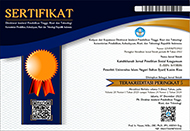Teknologi Pengawetan (Hay) dan Kualitas Nutrisi Murbei (Morus alba) yang Ditanam di Lahan Gambut Sebagai Pakan Ternak Ruminansia
Abstract
This research was conducted on peatland (type sapric) at research farm of laboratory agrostology, feed industry and soil science, Faculty of Agriculture and Animal Science, UIN Suska Riau on April to October 2013. This research aims to exploited and enhanced the potential of peatland as forage land, and utilizing mulberry as alternative feed and protein source for ruminant feed supply throughout the year. The study consisted of two phases of experiment. The both of experiments were set up in randomized complete block M5 = Mulberry harvested at 5 weeks of maturity, (2) M7 = mulberry harvested at 7 weeks of maturity, and (3) M9 = mulberry harvested at 9 weeks of maturity. The three treatments in second experiment were: (1) HM5 = Hay mulberry harvested at 5 weeks of maturity, (2) HM7 = Hay mulberry harvested at 7 weeks of maturity, and (3) HM9 = Hay mulberry harvested at 9 weeks of maturity. Results of this study showed that mulberry planted in peatland (type sapric) at 9 weeks of maturity had higher production compare 5 and 7 weeks of maturity. This indicated that the older the harvest age of mulberry produced more yield. Hay mulberry harvested at 9 weeks of maturity had lower nutritive value compare 5 and 7 weeks of maturity. This suggested that the older age led to low quality of hay mulberry. Based on overall research data concluded that mulberry harvested at 7 weeks of maturity in peatland resulted in a better quality hay mulberry than 5 and 7 weeks of maturity as a source of forage and protein alternative for ruminants.
Keywords
Fodder tree; harvest age; production; quality
Full Text:
PDFDOI: http://dx.doi.org/10.24014/kutubkhanah.v16i1.231
Refbacks
- There are currently no refbacks.
 Jurnal kutubkhannah is licensed under a Creative Commons Attribution 4.0 International License. View My Stats
Jurnal kutubkhannah is licensed under a Creative Commons Attribution 4.0 International License. View My Stats









